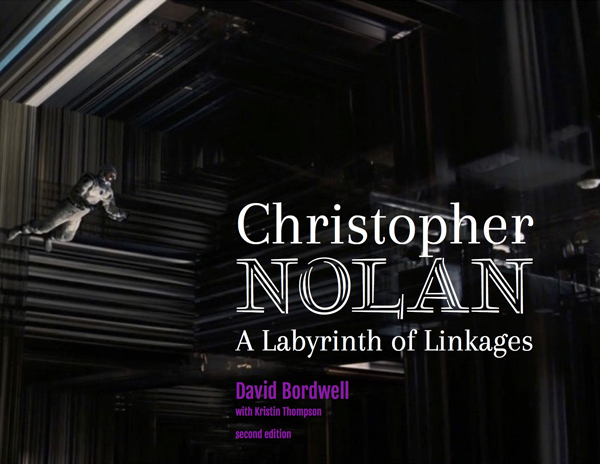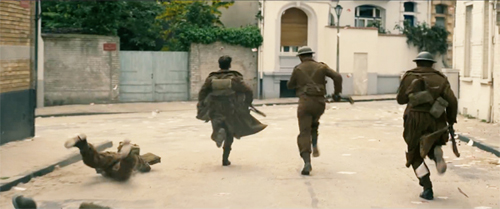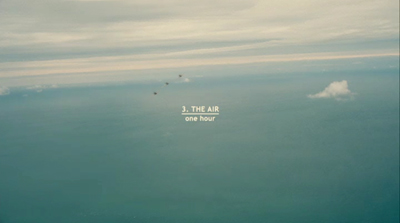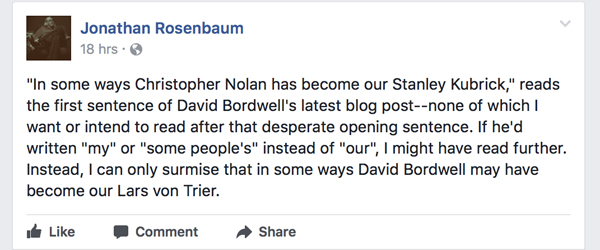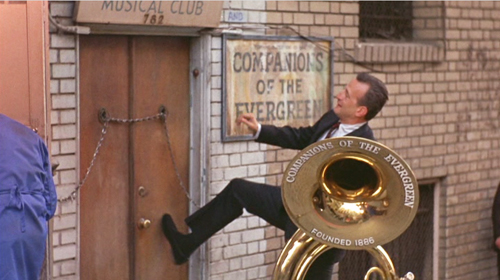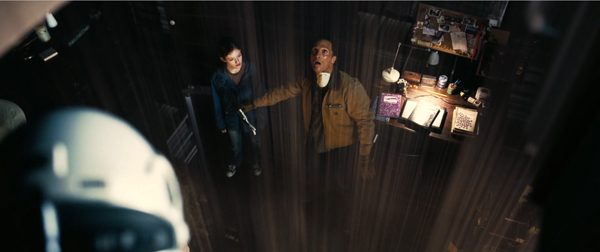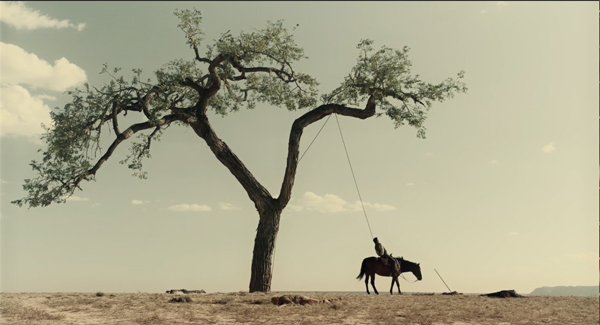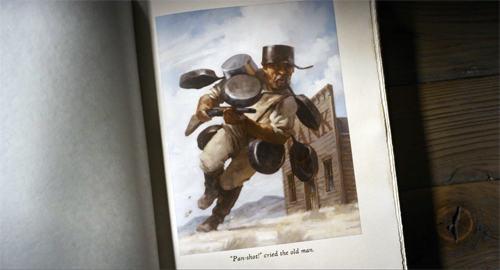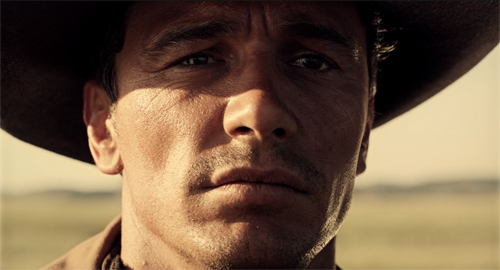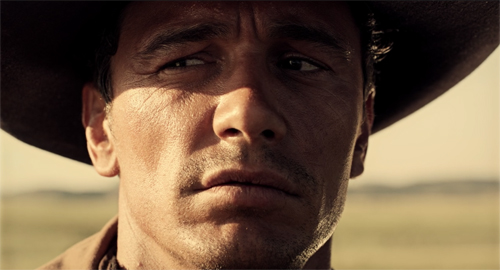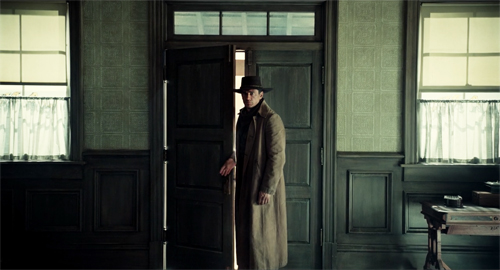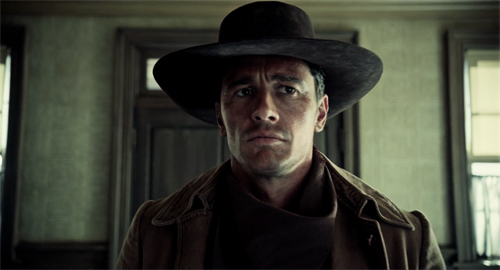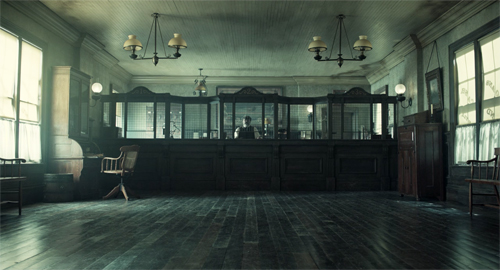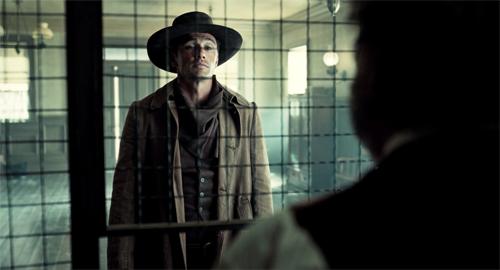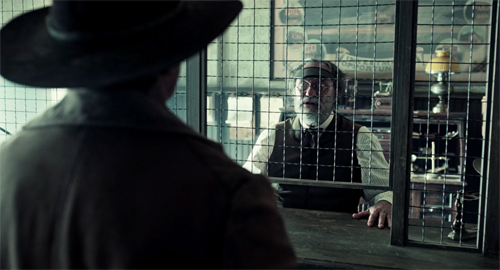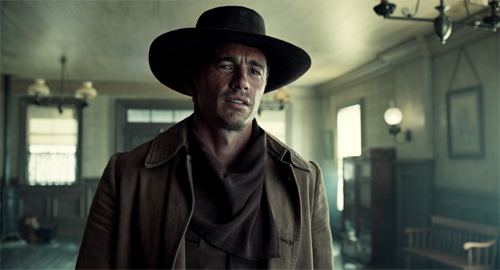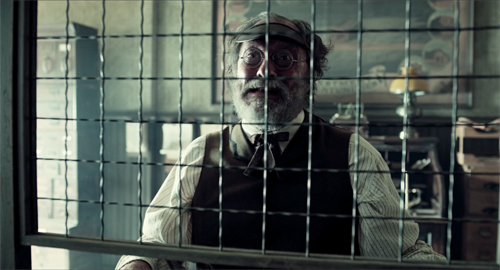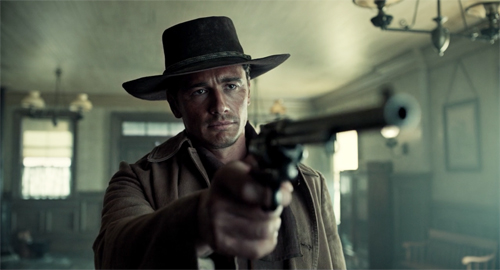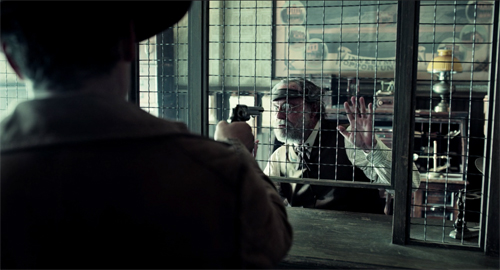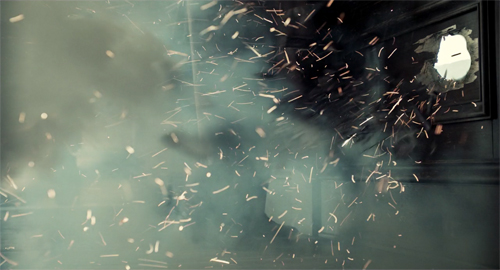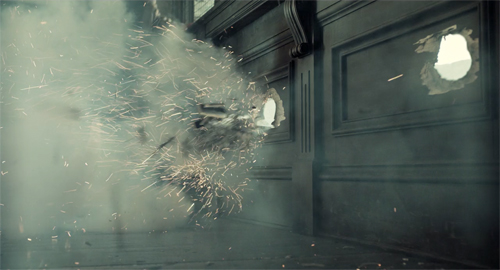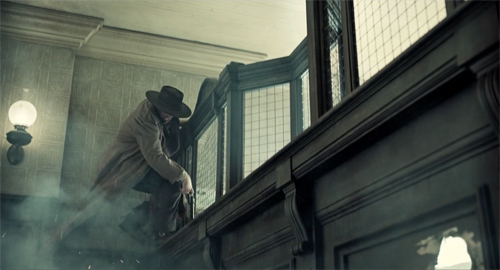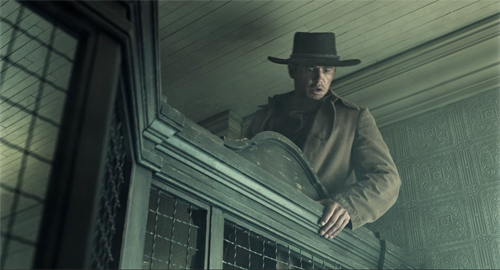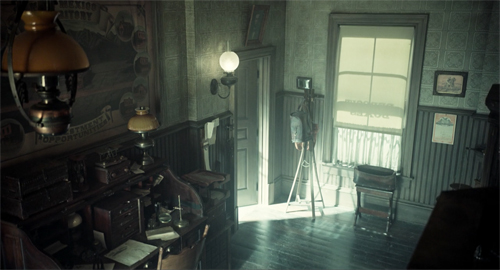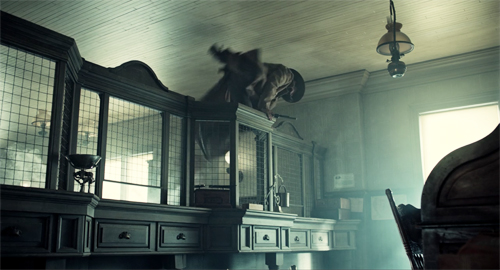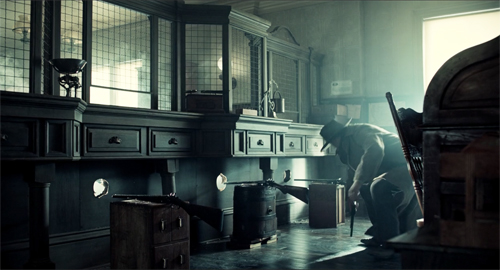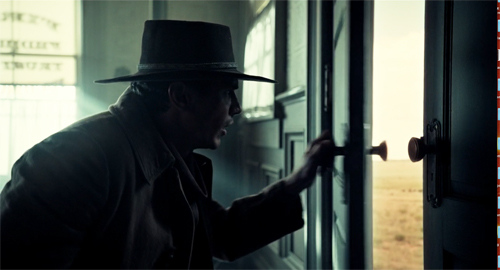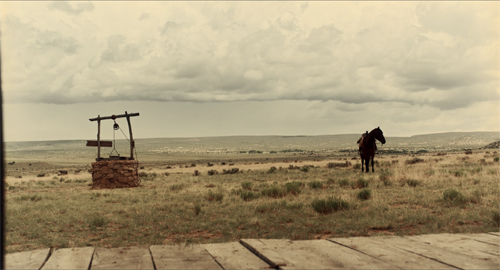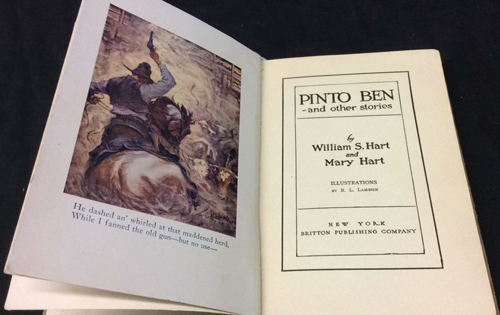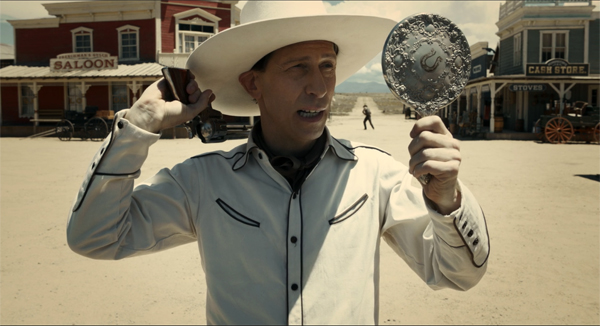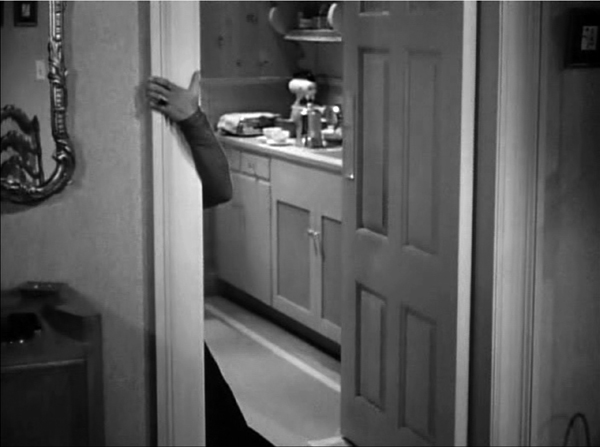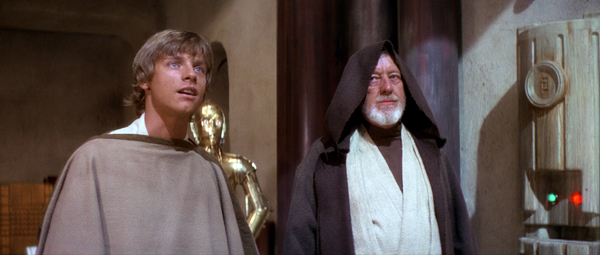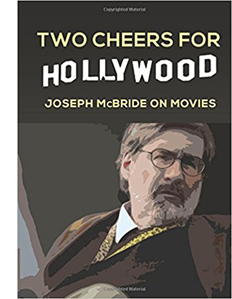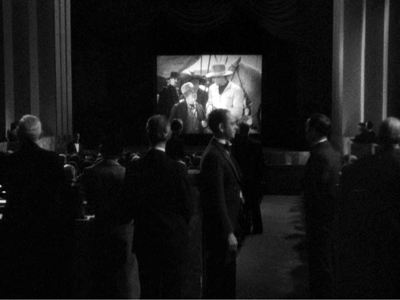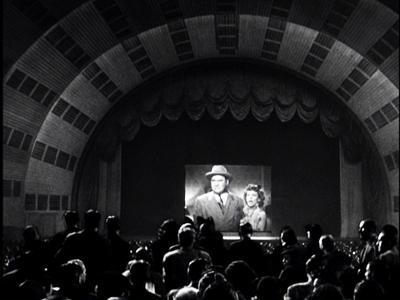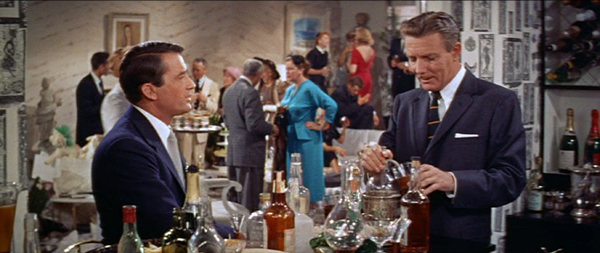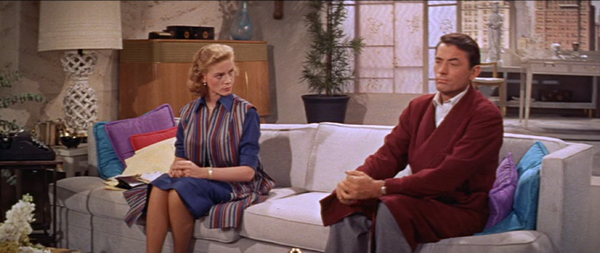Archive for the 'Film criticism' Category
Nolan book 2.0: Cerebral blockbusters meet blunt-force cinephilia
You want to go see a film that surprises you in some way. Not for the sake of it, but because the people making the film are really trying to do something they haven’t seen a thousand times before themselves. . . I give a film a lot of credit for trying to do something fresh—even if it doesn’t work.
Christopher Nolan
DB here:
Christopher Nolan has scheduled a new film for summer 2020. That’s all we know at this point. It’s a nifty coincidence that this week we’re releasing the second edition of our little e-book, Christopher Nolan: A Labyrinth of Linkages. It’s now available for purchase at $3.99.
Kristin and I have rewritten and expanded the 2013 edition to include discussions of Interstellar and Dunkirk. In addition, I’ve taken the opportunity to develop some new arguments about Nolan’s career. In particular, I claim that he has developed a consistent and fairly adventurous “formal project” revolving around the treatment of cinematic time. I also consider his efforts to make what the industry calls “event films” and The Hollywood Reporter calls “cerebral blockbusters.”
My online exploration of those ideas got me into trouble some while back. A well-known critic vehemently criticized my blog entry on Dunkirk while announcing that he refused to read it. His Facebook fulminations taught me a few things about internet culture and film reviewing, and I’ll try to spell some of them out shortly. First, though, let me introduce the new version of our book.
Preview
Dunkirk (2017).
The earlier edition was in portrait format and contained embedded video clips. The new version is squeezed into the more grateful landscape format and contains links to online clips. This makes the file less bulky to download. As you’d expect, we’ve added more clips, from The Prestige, Interstellar, and Dunkirk.
The book’s argument has four strands.
(1) Nolan is best understood as working with traditions and trends in contemporary American cinema. Following and Memento blend classic studio conventions (chiefly of film noir) with independent cinema’s tendency toward “complex storytelling” at the end of the 1990s (partly due to Tarantino’s influence). His Dark Knight trilogy aimed to bring serious themes to the emerging comics-superhero model. Our book has little to say about the Batman franchise, except insofar as it encouraged Nolan to try various stand-alone experiments.
A trend toward “intellectual” genre cinema, seen especially in The Matrix (1999), gave Nolan the opportunity to make his “cerebral blockbusters”; the Wachowskis’ film became a model for Inception. Important as well was the impulse toward richly realized story worlds (“worldmaking”) pioneered by Lucas’s Star Wars franchise and carried along in the fantasy and SF genres.
(2) Contemporary American cinema has enabled a few directors to launch “formal projects.” A filmmaker can develop a signature style or method recognizable from film to film. Wes Anderson is perhaps the clearest example in the US, although Hong Sangsoo is a good overseas instance. I argue that Nolan quite self-consciously launched a distinctive formal project in his work, applying it to a variety of subjects and genres. A new chapter develops this idea.
What is this formal project? I’d say it consists of experiments with cinematic time by means of techniques of subjective viewpoint and crosscutting. From Following to Dunkirk, Nolan has explored various ways of manipulating story time and the viewer’s experience of it. I devote a new chapter to spelling out the idea, taking seriously his emerging idea of a “rule set.” The rule set not only governs the film’s construction but becomes a guidance device that spectators must learn to understand the story.
After using Following and Memento to illustrate Nolan’s overall project, the book devotes later chapters to showing how rule sets shape The Prestige’s dual-protagonist plot, Inception’s nested-dream device, Interstellar’s time-travel agenda, and Dunkirk’s three levels of story duration. In the course of these chapters, I try to show how Nolan addresses criticisms that his work is emotionally cold (one chapter is called “Pathos and the Puzzle Box”) and how he has managed to develop his project in the framework of genres and studio “event pictures.” The biggest challenge is clarity: keeping the audience up to speed with story action when plotting and narration are fulfilling the sometimes arcane rules.
(3) The first edition of our book began by acknowledging that Nolan’s work divides audiences. Many film viewers like his films, some consider them masterpieces, and others consider them worthless. Here’s the new book’s opening, slightly modified from the first edition.
Paul Thomas Anderson, the Wachowskis, David Fincher, Darren Aronofsky, and other American directors who made breakthrough films at the end of the 1990s have managed to win either popular or critical success, and sometimes both. None, though, has had as meteoric a career as Christopher Nolan.
As of fall 2018, his films have earned over $4.7 billion at the global box office, and at least as much from cable television, DVD, and other ancillary platforms. On IMDB’s list of the top 250 movies, as populist a measure as we can find, The Dark Knight (2008) currently ranks number 4 with nearly two million votes, while Inception (2010), at number 14, earned over 1.7 million. Francis Ford Coppola, Steven Spielberg, and Peter Jackson each have three films in the poll’s top 50. Nolan is the only director to have five.
Remarkably, many critics have lined up as well, embracing both Nolan’s blockbusters and his more offbeat productions, like Memento (2000) and The Prestige (2006). From Following (1998) onward, his films have won between 76% and 94% “fresh” ratings on the aggregating website Rotten Tomatoes. Even Insomnia (2002), probably his least-discussed film, earned 92% “fresh.” Nolan is now routinely considered one of the most accomplished living filmmakers.
Yet some critics fiercely dislike his work. They regard it as intellectually shallow, dramatically clumsy, and technically inept. People who shrug off patchy plots and continuity errors in ordinary productions have dwelt on them in Nolan’s movies. The vehemence of the attack is probably in part a response to his elevated reputation. Having been raised so high, he has farther to fall.
More on the critical controversy below. At this point, it’s enough to say that our book argues that Nolan’s formal project illuminates certain capacities of cinema. He shows us some new things that cinema can do.
Innovation, then, is another strand in the argument. We pick up on Nolan’s suggestion that all other things being equal, innovation is worthwhile. (“I give a film a lot of credit for trying to do something fresh….”) Our opening chapter (“How to Innovate”), retained from the first edition, continues:
I admire some of Nolan’s films, for reasons I hope to make clear. I have some reservations about them too. Yet I think that all parties will agree that Nolan seeks to be an innovative filmmaker. Some will argue that his innovations are feeble, but that’s beside my point here. His career offers us an occasion to think through some issues about creativity and originality in popular cinema.
After decades of trying to trace the bounds of novelty in popular cinema, I think that Nolan’s work shows that the conventions of popular cinema are intriguingly flexible. As in the silent era (see many of our entries, especially those on the 1910s), as in the 1940s (see Reinventing Hollywood), as in the 1990s (see The Way Hollywood Tells It)—today’s American cinema can accommodate intriguing experiments in storytelling. There are limits, of course, but they aren’t as rigid or strict as some think.
Put more theoretically, the capacity of classical storytelling to exhibit “trended change” allows classical principles to be instantiated in various unforeseeable ways. This entry explains the argument a bit more.
4) Where does this leave the critics who despise Nolan’s work? The book argues that critics should be more open to the cinematic implications of the movies they encounter. They shouldn’t consider a film they may dislike merely as something to be dismissed or another nail in a despised director’s coffin or an occasion for displays of writerly cleverness. (The recent victim is Serenity. Maybe the umbrage is deserved, but it makes me want to take a look.)
Critics concentrating on evaluation can miss how even films they don’t consider good or likable can shed light on the possibilities of cinema. As our introduction puts it:
Taking this stance suggests that it can be useful to look at the artistic history of films apart from our urge to rate goodness and badness.
Once again, I find myself agreeing with Nolan’s remark quoted at the top of this entry. Even though something fails, it can be worth trying if it opens up some creative possibilities. Critics could signal these, if they chose.
These four ideas, along with detailed analyses of Nolan’s films, form the substance of the book. You can buy a copy on our order page, which contains more information and a table of contents.
The follies of Facebook
After the internet, nothing seems weird. Still, the August 2017 email from an overseas friend took me by surprise. It was headed “Re: Rosenbaum” and began: “What a turd!” before continuing in a similar vein.
Jonathan Rosenbaum has my permission to stop reading this now.
I don’t do Facebook or any other social media myself, so I had no idea what my friend was referring to. Using Kristin’s account, I learned that on a Facebook page JR had posted the remark you see above in response to my blog entry on Dunkirk. (That entry has developed into a chapter in our book.)
I was mostly bemused by the Facebookery. Actually, I didn’t understand it.
I didn’t understand the reference to Lars von Trier, whom JR has praised many times.
I didn’t understand what was desperate about my effort to grasp Nolan’s latest release as part of a larger trend toward event films as “personal” projects, typified in earlier times by Kubrick’s work.
I didn’t understand the objection to my use of “our,” which the entry clearly indicates as referring to mainstream US film culture today.
I didn’t understand how I could stagger someone by comparing two notable filmmakers. Nothing I said in what followed suggested I was comparing them on grounds of quality. Indeed, had JR checked our blog or read our book, he’d learn that I’ve written about both flaws and strengths of Nolan’s work.
Above all, I couldn’t understand why someone would refuse to read further, and then proudly tell his Facebook Friends™ he did it. This seems curiously close-minded, especially when six minutes of Googling dredges up many passages in which JR castigates critics for refusing to see movies they comment on.
Wolcott’s deepest scorn was reserved for those “sullen Village Voice reviewers” who “praise movies so obscure that simply getting to the theater counts as a quest for the authentic.” One of them, he pointed out, had the nerve to write hyperbolically about a recent Godard video — something that Wolcott presumably couldn’t be bothered to see himself.
“[Godard’s] most recent films,” I concluded, “are simultaneously investigations into and lessons about how to see, hear and understand our everyday existence. Regardless of how one ultimately judges them, it is irresponsible to call them frivolous; far more frivolous is the critical intelligence which refuses to grapple with them.”
I saw as well that some of his Friends™, who also had not read the piece, had joined the chorus. Still, Facebook isn’t exactly an arena of Ciceronian subtlety. So I shrugged. Why not let JR and his Friends™ blow off steam?
But a few of his Friends™ bothered to read my piece and pointed out that his reaction misunderstood my points. And some who hadn’t read the piece began treating my first sentence as an essay question in Contemporary Movies 101 by speculating on what evidence might warrant it. Indeed, some of his readers arrived at claims akin to mine.
JR responded by escalating. He had to go and compare me, on obscure grounds to Trump–a figure I’ve castigated on more than one occasion. To this I demanded an apology.
JR replied on Facebook with an excuse masquerading as an apology. As I’d predicted, he shifted the grounds of the original objection. Turns out it was my fault: he claims that my first sentence misled him because it was so poorly written. (Sorry to report, it remains in the Nolan book.) The whole thing–starting silly, turning a bit nasty, and ending with the critic scuttling off trailing a cloud of muttered gripes–exemplified yet again the superficiality that Facebook encourages.
My email correspondent might call it a close encounter of the turd kind. Still, I think I learned things. I began to think again about how criticism that depends heavily on evaluation can lead to a dogmatism about taste and a close-mindedness that blocks intellectual inquiry.
Call it blunt-force cinephilia.
A brief guide to militant cinephilia
Petulia (1968).
In an earlier entry, I argued that critics do lots of things with language. They describe artworks; they analyze them; they interpret them; and they evaluate them. Typically, academic critics concentrate on description, analysis, and interpretation. Evaluation usually takes the back seat.
By contrast, journalistic critics, aka reviewers, heavily weight evaluation. After minimally describing the film, they offer consumer recommendations. They guide us to recent releases that they favor and steer us away from ones they don’t. But evaluation, I claimed, can appeal to two standards: more or less objective criteria of judgment and more or less subjective tastes. The reviewer may appeal to criteria that readers share (a thriller shouldn’t have plot holes, a comedy should induce laughter), or to tastes.
Tastes are subjective, but they’re also shared with others. I like even somewhat cheesy kung-fu films, and maybe you do too. I’m not prepared to call them excellent on objective criteria, but they give me pleasure. A reviewer often signals a film’s taste dimension with “If you like this sort of thing, you’ll probably like this new film.”
But some reviewers, as they acquire knowledge of films and film history and film culture, build up a cluster of distinctive tastes. And some reviewers become well-known, and they gather followers. Soon the critic’s preferences and hatreds become part of the critic’s public identity, and the followers align their tastes, to one degree or another, with the critic’s.
And when a critic becomes a celebrity, he or she may be tempted to make tastes part of the brand, to minimize judgment based on criteria and exaggerate the importance of tastes. And to whale away on films aimed at alien tastes.
One branding option, popularized I think by Pauline Kael, was a sort of weaponized evaluation. Bad films weren’t simply slipshod or shallow, but they were outrages, profound insults to cinema and humanity. “Is there any art in this obscenely self-important movie?” Kael asked of Petulia.
Militant cinephilia of this sort offers all sorts of rhetorical advantages. It paints the possessor as a pure guardian of what’s valuable. It allows the critic to write wildly, spraying bullets at many targets, so it has a jittery readability. It encourages hatchet-wielding, since most films won’t measure up. Demolition jobs, like Godzilla movies, are fun.
Dogmatic cinephilia also favors the narcissistic personality who disdains dialogue or common pursuit of ideas. And it glamorizes the critic’s brand. Who would want to be sane, reasonable Stanley Kauffmann if you can cheer Kael wrestling with the demons of commerce? This is how cults of personality grow.
Militant cinephilia rests largely on the critic’s taste arsenal. Deployed carefully, it can yield good results–stimulating conversation, pointing out faults and beauties in films. But cinephilia turns dogmatic when the tastes keep you from considering evidence or alternative arguments. Ironically, the dogmatic cinephile winds up limiting cinephilia, and cinema itself.
As a sketch, I’d offer this list of symptoms of blunt-force cinephilia.
You see it or you don’t. The critic makes sweeping claims, usually in the form of piled-up adjectives, without much evidence.
Differ if you dare. The critic simply negates any opposing views by attributing disagreement to base motives or a blinkered assimilation to dominant tastes. You cashed in, sold out, unthinkingly accepted what you were told.
Fondness for the sideswipe. If dogmatic cinephiles were forced to justify their claims in some detail , they might nuance them. But reviews, like Facebook postings and tweets, have to be brief. (No time or space to go deep.) They favor short, sharp bursts of dislike, zingers, what in another context Matt Taibbi calls “anger chiclets.” The same scattershot approach can be found in longer pieces as well, where a celebrity critic can pile up strings of pans or panegyrics.
My cinephilia can lick your cinephilia. When you overstate (or “overreact,” as JR puts it in his Facebook apology), as you inevitably will, it’s because you just love cinema so much. Your passion is so volcanic that of course sometimes it will burst the bounds of reason. Never say “It’s only a movie!” Movies matter tremendously! See how much I care? My vehemence is righteous, and I smite the sinful.
The mutation of militant cinephilia into dogma brings us back to JR’s outbursts. If you’re a critic defining yourself largely by tastes, my fairly bland sentence about Dunkirk can look like an armed provocation. Dogmatic cinephilia can operate on a hair-trigger.
More basically, I suspect that JR doesn’t welcome film criticism that suspends or just ignores evaluation. But I think it’s not only possible but desirable to hold evaluation in check if we want to know how films work and work on us.
The writing we do on this blog and in our publications is of course fueled by love–of the medium, of filmmakers, and of films. Evaluation mostly enters as a choice of what to talk about. We tend to write about films we think are good by some criteria. Usually, we like them as well. Sometimes we try to convince you to rank them high and come to like them.
Still, many of our points should hold good independent of evaluation. Often we try to see films as affording glimpses into cinema’s artistic practices (conventions, strategies) and, when we encounter novelty, its fresh possibilities. This is at bottom the premise of the Nolan book.
Both journalistic reviewers and high-end critics often lack curiosity. They don’t seem to think that films can teach them anything about cinema they don’t already know. We, like Nolan in our opening quotation, want to be surprised by something, even if it doesn’t quite come off. At the limit, we try to learn things about cinema from films that others, or even we ourselves, might not like. That’s another valid way, we think, of being a cinephile.
For more on our Nolan book, see this entry.
An older blog entry considers other games cinephiles play.
Besides the Nolan book, what would criticism that plays down evaluation look like? Many of our blog entries and books try to hold judgment and tastes in abeyance in order to answer research questions about form and style. See, for an example of a film that has ardent supporters and skeptics, our entries (here and here) on La La Land. For a wider effort to compare several films without emphasizing value judgments, try my roundups of narrative strategies in releases of 2015 and 2017. Then there are the older essays on Mission: Impossible III and staging in 1910s Nordisk films. For more extended examples see the book Poetics of Cinema.
Interstellar (2014).
The spectacle of skill: BUSTER SCRUGGS as master class
The Ballad of Buster Scruggs (2018).
DB here:
Craft isn’t everything in art, but it counts for a lot. Even when you’re going against tradition, you can’t just willy-nilly do whatever. You need to create a counter-craft (as Bresson, Brakhage, Ozu, and others showed us). Reviewers, in their urge to thump out quick judgments, often don’t address craft practice directly. So if we simply talk of the Coens’ Ballad of Buster Scruggs as a grim, occasionally grotesque and zany take on Western conventions, we’re apt to take for granted just what a trim, absorbing piece of sheer filmmaking it is.
It’s worth attuning ourselves to what Adam Gopnik called his collection of Robert Hughes’ writings: The Spectacle of Skill. Paying attention to that enhances our appreciation for what filmmakers accomplish, and maybe it can nudge aspiring filmmakers to consider things to try.
So, herewith a quick analysis of the very beginning of the film’s second episode. The whole piece is not as audacious as the title episode, and not as poignant as “Meal Ticket” or “The Gal Who Got Rattled.” It’s more of a light interlude. But we shouldn’t let its shaggy-dog payoff (“Your first time?”) make us think there’s anything slapdash about it.
There follow spoilers.
All the meanness in the Used-To-Be
In the book that frames each tale, this one is called “Near Algodones.” As in the other episodes, an illustration prepares us for something we’ll see in the scene. The caption reads: “Pan-shot!” cried the old man.
Lesson 1: Make everything clear and simple, except what you want to suppress.
A master shot gives us the elemental situation: A bank, a well, and a lone rider with his horse.
These are the central components of the sequence. The isolation of the bank makes it a plausible target for a holdup. The geography will become important in the second stretch of the scene, while the well will provide cover to the Cowboy. His horse will prove notably reluctant to move.
Lesson 2: Attach the narration to a single character.
Throughout this episode, we’re “with” the Cowboy, not always through exact optical POV but more generally: our range of knowledge of the unfolding situation approximates his. This sort of restriction arouses curiosity (what’s going on in the bank?), as well as suspense and surprise (as we’ll see).
Lesson 3: Motivate new shots by offscreen sound.
Attachment to the Cowboy is reinforced by the play of his attention. Over the Leone-esque close-up we hear a creak. This motivates a cut to the bank’s hanging sign. As we hear a thump, he shifts his eyes; we see it’s caused by the bucket bumping against the well.
Lesson 4: Delay when you can.
Attachment doesn’t mean immersion. Instead of a shot from the Cowboy’s POV as he’s entering the bank, we get him pausing to size up the scene.
Only then do we get a shot of the bare bank and the teller’s windows, which (thanks to a wide-angle lens) seem impossibly far away.
Lesson 5: Let expectations go to work.
The holdup scenario, a convention of Westerns, is surely hovering in many viewer’s minds. When the Cowboy advances, we wait to see if our expectations pay off. You get suspense simply by having your actor move forward; what could be more economical?
Lesson 6: Prepare for later shots.
The tracking shot of the Cowboy’s boots and spurs might seem mere decoration, but it further delays his arrival at the window and sets up an important shot to come.
Lesson 7: Scale your shots according to the information they present.
Reverse shots are the workhorses of mainstream storytelling cinema. They are vehicles for character interaction, either based in dialogue or just the exchange of glances. The over-the-shoulder (OTS) version specifies the spaces the characters occupy, typically in a conversation. OTS framings also serve as a transition to closer views. Here the Cowboy’s goal in the scene is to learn how fortified the bank is against robbery.
After the opening stretch of purely visual storytelling, dialogue takes over. For us to grasp it better, the OTS framings give way to singles, which enlarge the teller’s performance and the Cowboy’s reactions.
The geezer’s chatter joins the motif of flowery monologues and eloquent bafflegab we’ll encounter throughout the film. The framing also lets us enjoy the performance, which suggests that this scatterbrain might be an easy mark. He does, however, mention that he has put down one attempted robber and “shredded the legs” of another.
The climax of the exchange is the Cowboy’s drawing his pistol and the teller’s explanation that he has to stoop to get “the large denominations.” The result is more shot-scale calibration: We need a single to see the gun looming (an OTS wouldn’t be as punchy), but the reverse shot can be OTS because we need to see how the teller’s stooping maneuver is concealed from the Cowboy. We are still attached to him and what he knows–or doesn’t know.
Another benefit: as variants of framings we’ve seen before, these let us quickly grasp what’s new in them (brandishing the pistol, ducking down).
Lesson 8: Use a cut, a crisp gesture, or a discrete sound to arrest attention.
Actually, the next shot does all three. The Cowboy tries to peer over the till, and a shot shows him taking a step forward as we hear a click. This framing pays off the shot of striding boots we saw in Lesson 6.
Within the same shot, the front of the teller’s window is blasted open. The Cowboy jumps sideways as another hole explodes, then another.
We’re back to visual storytelling. Now we understand why the teller has “shredded the legs” of another would-be robber. When the debris clears, a camera tilt shows that the Cowboy has sprung to the counter.
A mini-spectacle of skill: Handling the three blasts and the Cowboy’s evasion in a single percussive shot.
Lesson 9: Stagger the reveals.
Alexander Payne once remarked: “Whenever you can do a reveal, do it.” Here we have a suite of reveals, but they’re handled in a simple, cogent way.
When the Cowboy crouches on the counter, we have several questions. Is the teller going to fight? What created the blasts? And will the Cowboy get to the money?
These questions are answered, purely pictorially, in the shots to come. First, from his perch the Cowboy sees the partly open door. The teller has escaped, but because we’re restricted to the Cowboy’s perspective, we don’t know where he’s gone.
Just as one concise shot showed us the gunblasts and the Cowboy’s leap to the counter, now his descent and landing, followed in a single tilt, reveals the teller’s infernal machine: a row of shotguns poised to fire.
Another director would have devoted a POV shot to this revelation, but here it’s provided without fuss or forcing, as we follow the Cowboy’s crouch. He barely reacts and smoothly sets about finding the money. He grabs it in a single crisp close-up. And another cut takes us to the doorway, as the Cowboy hopes a view outside will reveal where the teller has gone.
Once more a POV is recruited, but it shows how much our protagonist doesn’t know.
The elements we were given at the start–bank, well, horse–are laid out again, from the opposite angle. Thanks to the clarity of presentation, we fully understand that the old teller is hiding somewhere (probably with his lauded scattergun) and the Cowboy has to make a run for it. But to where?
There are other things to talk about here, such as the homages to Leone (the mention of Tucumcari from For a Few Dollars More, the creaking of the sign recalling Once Upon a Time in the West‘s operatic opening). Perhaps the device of the book owes something to William S. and Mary Hart’s Pinto Ben (1919).
But we’re so used to considering the Coens pasticheurs that these allusions don’t interest me as much as the compact finesse of their style.
The rest of this scene will depend on reworking the narrative, auditory, and pictorial elements we’ve already encountered. You could go through that, and indeed the rest of the film, and trace the artisanal precision on display. (Let alone the sheer boldness of certain depth shots.) And the Coens are expert at using visual ideas for humor, as in the later scene when the Cowboy’s horse, browsing for more grass to nibble, stretches his noose-rope to the limit (see top image).
But I think I’ve said enough to indicate how rich an apparently straightforward handling can be. When we speak of careful pacing; when we think of building a scene; when we think of a movie that’s easy and graceful to follow, what Otis Ferguson called “a smooth clear line”–this is what we’re talking about.
There’s plenty of spectacle here, what with landscapes and gun blasts, but there’s another sort of spectacle as well: the quiet virtuosity of craft. You don’t see it that often these days, so when we encounter it, we should acknowledge it.
For another study of the Coens’ technique, see Jim Emerson on No Country for Old Men.
Other blog entries celebrate this sort of precision. See, for example, this analysis of Panic in the Streets, or the mind-boggling visual engineering of Fritz Lang (here and here). Otis Ferguson’s ideas about smooth cinematic storytelling are discussed in The Rhapsodes: How 1940s Critics Changed American Film Culture.
My first impressions of Scruggs, after seeing a magnificent big-screen presentation in Venice, are here. Netflix and Annapurna are to be congratulated for backing this movie, but it really deserves a wider theatrical release than it got. At least, please give us a Blu-Ray!
The Ballad of Buster Scruggs (2018).
Geoffrey O’Brien reviews REINVENTING HOLLYWOOD in NYRB
Backfire (1950).
DB here:
The New York Review of Books has just published a review by Geoffrey O’Brien of Reinventing Hollywood: How 1940s Filmmakers Changed Movie Storytelling. This is a big deal for me.
I never thought my work would be reviewed in a publication I’ve subscribed to since my college days. And to be reviewed by O’Brien is a special honor. He’s one of those wide-ranging intellectuals who are rare today. He writes fiction and poetry, and offers criticism of film, literature, music, painting, and theatre. He’s ideally equipped to appraise my arguments about how 40s cinema drew on narrative conventions in adjacent arts. He’s also a connoisseur of the obscure and marginal in classic studio cinema.
I especially admire his writings on noir film and literature, on popular music, and his study of American cinema as a sort of popular hallucination. The Phantom Empire makes this case memorably, but the opening of his review catches the flavor too.
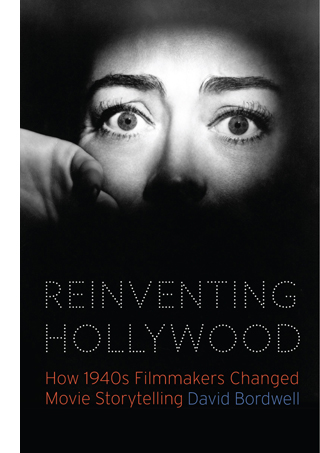 One night not long ago I found myself once again drawn into a movie from the tail end of the 1940s. This one, with the thoroughly generic title Backfire (not to be confused with Crossfire or Criss Cross or Backlash ), did not come with a high pedigree. It had sat on the shelf for two years after it was filmed in 1948, and afterward seems to have faded quickly from recollection. But movies of that time, when they emerge decades later, have devious ways of holding the attention: beguiling hooks and feints lead deeper into a maze whose inner reaches remain tantalizing no matter how many times those well-worn pathways have been explored, and no matter how many times the interior of the maze has led only to an empty space.
One night not long ago I found myself once again drawn into a movie from the tail end of the 1940s. This one, with the thoroughly generic title Backfire (not to be confused with Crossfire or Criss Cross or Backlash ), did not come with a high pedigree. It had sat on the shelf for two years after it was filmed in 1948, and afterward seems to have faded quickly from recollection. But movies of that time, when they emerge decades later, have devious ways of holding the attention: beguiling hooks and feints lead deeper into a maze whose inner reaches remain tantalizing no matter how many times those well-worn pathways have been explored, and no matter how many times the interior of the maze has led only to an empty space.
In a state of suspended fascination only just distinguishable from the preliminary stages of dreaming, I remained absorbed as documentary-style scenes of wounded war veterans recuperating at a hospital in Van Nuys, California, gave way to progressively more disjointed and often barely comprehensible episodes: an unidentified woman creeping in the dark into a patient’s room with a message about a missing war buddy, a murder investigation, a cleaning woman peering through a keyhole in a fleabag Los Angeles hotel, a winding path from mortuary to boxing arena to gambling den to the office of a particularly corrupt doctor, a plaintive piano theme playing over and over accompanied by reminiscences of its origin in a far-off Austrian village. The story splintered into flashbacks, spiraling into deepening confusions of identity and chronology, punctuated, as if to keep the spectator awake, by a series of point-blank shootings.
All the while, the dialogue was evoking the trauma of wartime injury, questioning the difference between memory and hallucination, talking about nightclub rackets, tax evasion, gambling debts, obsessive love, as the narrative coiled in its final swerve toward a strangling, silhouetted on a bedroom wall while Christmas carols were sung in the background. And then, abruptly, the nightmare was over, we were back in the veterans’ hospital after a second and successful round of rehabilitation, and the three surviving principal characters were even managing to laugh as they took off in their jeep for Happy Valley Ranch. By then I could hardly have said what the movie was about or even if it was especially good—few viewers have ever thought so—yet could not deny that something had caught me in its grip and stirred up troubling associations, like partially retrieved memories of a parallel life.
Apart from wishing I could write like this, I find myself agreeing. Popular culture does offer us a phantasmagoric alternative world that we can drift through in an almost somnambulistic way. I don’t see this argument as the sort of Zeitgeisty criticism I’ve complained about elsewhere. Rather, I think it’s in the spirit of Parker Tyler, who saw Hollywood not as reflecting a collective psyche but as building occasionally rickety story worlds out of cultural flotsam scavenged from wherever. Not a mirror but a mirage.
That hallucination demands that conventions and schemas, norms and forms, bring order to an occasionally demotic array of materials. Given this orientation, the sort of analysis I float in Reinventing Hollywood might seem to be overthought and flat-footed. But O’Brien gets into both the book’s research assumptions and its ambitions. He sees that I was trying to figure out how the dépaysment of Forties cinema stems from the frantic pressures of the industry, ambitious filmmakers itching to explore unusual narrative strategies, and the jolts that occur when time schemes collide, motives get muddled, and story premises wriggle out of control. To savor eccentricities, you need the sense of a center, and that’s where my inquiry starts.
It’s a generous review. O’Brien makes my arguments crisp and cogent, and he adds ideas of his own. It’s a review that both fans and nonspecialists can learn from, as I did. It’s also good to know that some of my jokes didn’t fall flat. (I can hear readers asking: Wait, there were jokes?)
For more on Reinventing Hollywood, go to the tag 1940s Hollywood. The book is available from the University of Chicago Press website and the mighty Amazon. As ever, I owe thanks to the University of Chicago Press staff, particularly Rodney Powell, Kelly Finefrock-Creed, Levi Stahl, and Melinda Kennedy.
I discuss Parker Tyler’s conception of the Hollywood Hallucination in The Rhapsodes: How 1940s Critics Changed American Film Culture.
Books not so briefly noted
“What a piece of junk!” Star Wars: Episode IV–A New Hope.
DB here:
Over there, across the room, a stack of more or less recently published books has haunted me for months. I wanted to tell you about them. True, I had plenty of excuses: My stay in Washington, a health nuisance, our trip to Bologna’s Cinema Ritrovato, and our looming deadline for a new edition of Film History: An Introduction. But excuses aren’t necessarily good reasons. My delay was especially painful because the books were by friends.
So here’s some penance. As usual, some of the books I’ve read completely; others I’ve read only stretches of. But each is on a fascinating subject, by people of sound mind and impeccable character–in other words, exceptional researchers, thinkers, and writers.
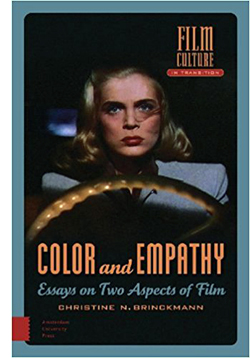 Christine N. (Noll) Brinckmann is both a critic and a filmmaker. In Color and Empathy, she brings hands-on expertise to two subjects too often ignored. Her essays treat the handling of color in silent cinema, 1950s Hollywood, experimental film, and Claire Denis’s Beau Travail. On the empathy side, she analyzes its role in documentary, Hitchcock films, and Eric de Kuyper’s Casta Diva.
Christine N. (Noll) Brinckmann is both a critic and a filmmaker. In Color and Empathy, she brings hands-on expertise to two subjects too often ignored. Her essays treat the handling of color in silent cinema, 1950s Hollywood, experimental film, and Claire Denis’s Beau Travail. On the empathy side, she analyzes its role in documentary, Hitchcock films, and Eric de Kuyper’s Casta Diva.
Noll is very good on what I’d call the “historical poetics” of color, starting from perceptual and technical aspects and moving to the ways conventions emerged historically. For example, she contrasts Pal Joey and Chungking Express: sharp-edged versus blurred, object colors versus ambient colors, narratively motivated color clusters versus poetic and associational ones. She introduces the useful concept of color “chords,” mingled hues that create motifs that weave through the film. With this concept she’s able to treat late 1950s Hollywood color comedies as having a “mannerist” style, with chords dissolving into moments of patches of pure abstraction. She finds this strategy in some very unexpected places; I never thought I’d need to look at Bob Hope’s Bachelor in Paradise again, but now it’s a must.
As a filmmaker, Noll is also sensitive to the bodily reactions of viewers. Empathy is one such general phenomenon. What I appreciated in her discussion was her eagerness to go beyond the usual sense of the term, which involves feeling for characters in an emotional register. By analyzing passages in Secret Agent and Frenzy, she also considers how visceral factors like motor mimicry play into our responses. She takes the face as the main arena of empathy, but gestures–like cracking open fingers closed in death–are central as well. Thanks to empathy, she notes, films align us with some fairly unpleasant people. “We have not invested any sympathy in the characters; we disapprove of their actions, yet wish them to succeed.”
As a filmmaker, Noll understands that films are made not with themes but with images and sounds, so her account of bodily engagement, like her analyses of color dynamics, is pervaded by the recognition that first of all a movie is a concrete experience engaging our senses and our minds. The critic can point to abstract meanings, but we’re also interested in the mechanics underlying those meanings, how movies arouse our appetites for action and emotion.
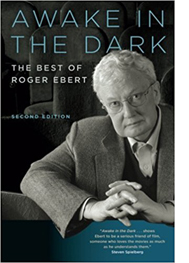
Two critics attuned to the many levels of a film’s appeals are represented in new collections. There’s now a second edition of Roger Ebert‘s Awake in the Dark: The Best of Roger Ebert, from the University of Chicago Press. The 2006 original, which contained his personal choice of his strongest reviews and essays through 2005, has been enhanced with new pieces on Roger’s favorite films from the years 2006-2012, the year before his death. Films covered are Pan’s Labyrinth, Juno, The Social Network, A Separation, and Argo, along with shorter notices on many more.
It’s clear that Roger’s abilities were undiminished despite his illness. As ever, he brings his own variety of empathy to the characters and story worlds displayed. His eye stayed sharp:”Del Toro moves between many of these scenes with a moving foreground wipe–an area of darkness, or a wall, or a tree. . .. The technique insists that his two worlds are not intercut, but live in edges of the same frame.” The dozens of pieces in the collection are full of warm, sensitive moments of appreciation. I have updated my introduction to add some further reflections on Roger’s legacy.
While Roger Ebert was starting his career in Chicago with a review of Bonnie and Clyde in 1967, Joseph McBride was at the University of Wisconsin–Madison, writing his own film criticism and working on his still valuable book on Orson Welles. A prodigy, yes. He moved to California the same year Kristin and I came to Wisconsin; we met him once, as I remember, just before he was about to leave. We’re kindred spirits, born sixteen days apart and bound by Boomer Auteurism.
Joe’s most famous screenplay is for Rock ‘n’ Roll High School, but he also scripted many of the AFI tributes. He’s a professional journalist and currently a university professor. But he is at bottom, as he readily admits, a book writer. His biographies of Capra, Spielberg, and Ford have become indispensable, while his memoir and analysis of Welles’ late career (What Ever Happened to Orson Welles?) is just as meticulously researched and intellectually ambitious.
Now Joe has given us a massive collection of his shorter pieces. Two Cheers for Hollywood, its ambivalent title echoing E. M. Forster’s Two Cheers for Democracy, includes a vast panorama of work. Journalist Joe, who has done over 15,000 interviews in his career, gives us a tempting sample here. He records encounters with screenwriters (Polonsky, Michael Wilson, Marguerite Roberts et al.) and directors (from Cukor and Wilder to Bernds, of Three Stooges fame). He talks with Stepin Fetchit in a Madison strip club and Peter O’Toole in the Beverly Wilshire (“his bony white hands and feet protruding from his royal purple robe like the wings of a great pale bird”). Saul Zaentz complains of “pseudo-stars” and Billy Wilder shows Walter Matthau how to rip out a phone cord in two jerks: “Zis is the first one, and the second zis is a ZUMP!” Each interview is prefaced by a thoughtful reflection on Joe’s own evolution as a writer.
Then there are the critical pieces, many of them magnificent. There’s the most detailed defense I’ve ever seen of the Coens, a nuanced investigation of Ford’s attitudes on race, a predictably acute account of Spielberg’s strengths and weaknesses, an appreciation of performance in Fahrenheit 451, a probing of Wild River (Kazan’s most Fordian film, methinks), and much, much more. The book contains 56 essays, all substantial. It runs to over 650 big pages. It lacks neither passion nor precision, just an index.
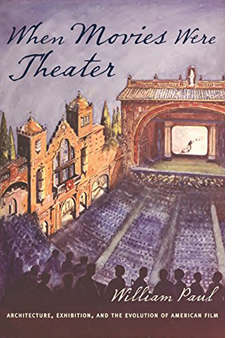 Another Boomer Auteurist is William Paul. Bill did some film reviewing in his younger days but became an academic like Noll and Joe and me. Currently Professor of Film and Media Studies at Washington University of St. Louis, he has written fine books on Lubitsch’s American films and on the tie between modern horror and modern comedy. What has consumed him in recent years is an in-depth investigation of the history of the movie house. When Movies Were Theater: Architecture, Exhibition, and the Evolution of American Film is the result, and it’s a landmark study.
Another Boomer Auteurist is William Paul. Bill did some film reviewing in his younger days but became an academic like Noll and Joe and me. Currently Professor of Film and Media Studies at Washington University of St. Louis, he has written fine books on Lubitsch’s American films and on the tie between modern horror and modern comedy. What has consumed him in recent years is an in-depth investigation of the history of the movie house. When Movies Were Theater: Architecture, Exhibition, and the Evolution of American Film is the result, and it’s a landmark study.
The broad historical arc moves, as you’d expect, from storefront theaters to picture palaces and then drive-ins and arthouses. But this is no simple account of buildings. Bill argues that the manner of presentation shaped the rise of the feature film, the recurring strategy of roadshows, the demands for double bills, and other factors of film form and industry conduct.
Bill suggests that the 1910s demand for “life-size figures” in film might have been a response to theater size, and he speculates that the move to closer shots in the 1920s might reflect enlarging venues. Makes you wonder if “intensified continuity” of the 1960s and thereafter owes something not only to TV as the ultimate destination of the images but also to the cramped screens of early “twinned” houses, those sticky-floored abominations.
As usually happens when a good historian dives deep, you get surprises. Bill uncovers floor plans with seats facing in the wrong directions, horseshoe-shaped venues, auditoriums packed with pillars, and other peculiarities. One counterintuitive thing that I learned was that screens were rather small for most of film history. A screen for a palace seating a thousand people might be only twenty feet across. Bill’s frames from Footlight Parade and Saboteur show views from the back of a playhouse, and they indicate that often the proscenium area wasn’t filled by the screen, which was cloaked in black masking.
The Hitchcock is of course a studio reconstruction of Radio City Music Hall, but Bill indicates that the proportions are accurate. In all, his When Movies Were Theater joins Douglas Gomery’s Shared Pleasures in showing, in sharp detail, just how varied and diverse American movie exhibition has been.
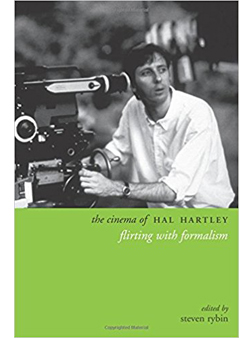 I would recommend Steven Rybin‘s anthology The Cinema of Hal Hartley: Flirting with Formalism even if I didn’t have a piece in it. For one thing, I too flirt with formalism. Hell, I nearly eloped with it. Second, my study of staging in Simple Men is pretty bare-bones compared to the rich and varied work on display in the other essays in the book. Steve has written widely on American film, both classic and contemporary (Malick, Mann). His introduction to the book ranges across a vast terrain, from models of independent film to debates about “smart cinema.”
I would recommend Steven Rybin‘s anthology The Cinema of Hal Hartley: Flirting with Formalism even if I didn’t have a piece in it. For one thing, I too flirt with formalism. Hell, I nearly eloped with it. Second, my study of staging in Simple Men is pretty bare-bones compared to the rich and varied work on display in the other essays in the book. Steve has written widely on American film, both classic and contemporary (Malick, Mann). His introduction to the book ranges across a vast terrain, from models of independent film to debates about “smart cinema.”
The essays that follow offer agreeably intricate analyses of Hartley as a romantic comedy director, of “small films,” of Parker Posey as a muse, and on the Henry Fool trilogy as centered on the implications of writing. I especially appreciated the way that all the contributors (Mark L. Berrettini, Jason David Scott, Steven Rawle, Sebastian Manley, Daniel Varndell, Fernando Gabriel Pagnoni Berns, Zachary Tavlin, and Jennifer O’Meara) show how Hartley’s authorial obsessions responded to conditions of production, industry pressures, or critical reception. It’s called context, and yields a body of criticism that does honor to a director still not as fully appreciated as he deserves to be.
Another thick context, Wisconsin-revisionist style, is on display in Bradley Schauer‘s Escape Velocity: American Science Fiction Film, 1950-1982. In working on my book on 1940s cinema, I was struck by the absence of today’s dominant genres: fantasy and science fiction. SF books and magazines became widely popular in the period but, apart from cheap serials, the genre had a delayed arrival on movie screens. When it did arrive, Brad explains, it was presented not as classic space opera but something else, what he calls “topical exploitation cinema.”
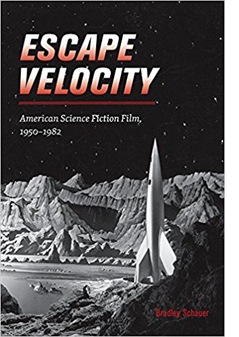 To escape the pulp associations of Flash Gordon, SF movies traded on current scientific discoveries and headline items like flying saucers. As often happens, it took a marginal player to push a new cycle. Eagle-Lion’s Destination Moon (1950) caught the attention of big studios, which embarked on mid-budget items like When Worlds Collide and The Day the Earth Stood Still (both 1951). Brad traces the cycle’s urge for legitimacy through special effects, more sophisticated narratives, and even appeal to Scripture. These developments were shaped by broader changes in the American film industry, especially concerning budgets and program policy.
To escape the pulp associations of Flash Gordon, SF movies traded on current scientific discoveries and headline items like flying saucers. As often happens, it took a marginal player to push a new cycle. Eagle-Lion’s Destination Moon (1950) caught the attention of big studios, which embarked on mid-budget items like When Worlds Collide and The Day the Earth Stood Still (both 1951). Brad traces the cycle’s urge for legitimacy through special effects, more sophisticated narratives, and even appeal to Scripture. These developments were shaped by broader changes in the American film industry, especially concerning budgets and program policy.
After spelling out this early history, Brad takes us through familiar titles from 2001 to Star Wars: Episode IV–A New Hope, but always fleshing out the story with new information and ideas. He shows that Kubrick gave his film prestige through art-cinema style and storytelling, while Lucas’s film gained traction by treating space-opera formulas with earnestness and respect rather than camp condescension. Brad analyzes important SF films that are often forgotten, like Logan’s Run and Rollerball. His discussion of Alien and Planet of the Apes reminds us that the current incarnations of these franchises have strayed somewhat from their original entries.
Again, the historian unearths surprises. Given the revulsion of today’s intellectuals toward Star Wars, which gets blamed for ushering in the Big Dumb Movie, it’s worth remembering that nearly all the critics praised it. Under the rubric “Fun in Space,” Newsweek‘s reviewer noted: “I loved Star Wars and so will you, unless you’re. . . oh well, I hope you’re not.” That’s sort of the way I feel about these books.
Earlier book-dedicated blog entries are here.
Designing Woman (1957): “There are three pillows stacked on each side of the sofa, and as if by chance they take up the colors of the party: red, turquoise, bluish-purple. . . . The color chord of the party becomes an end in itself, and the composition obtains a playful intrinsic value” (Christine Brinckmann, Color and Empathy, p. 48).












